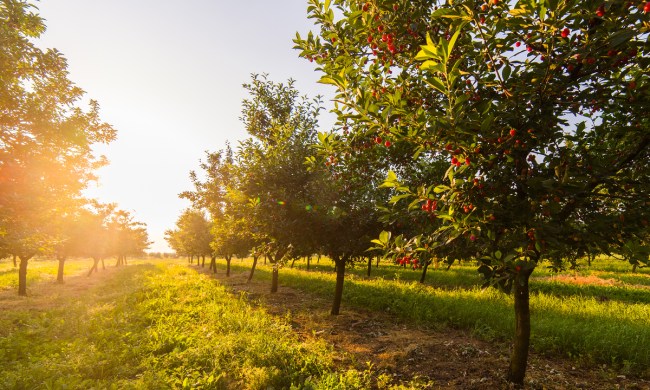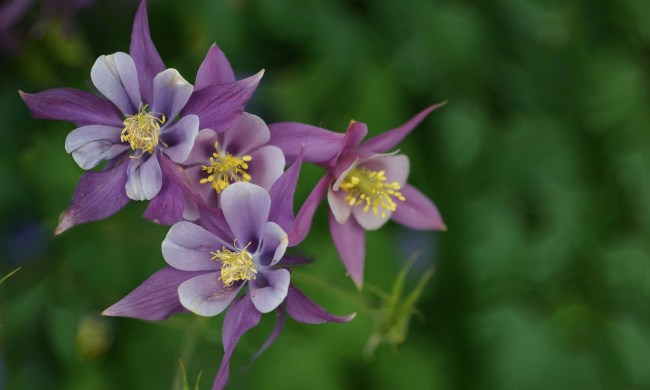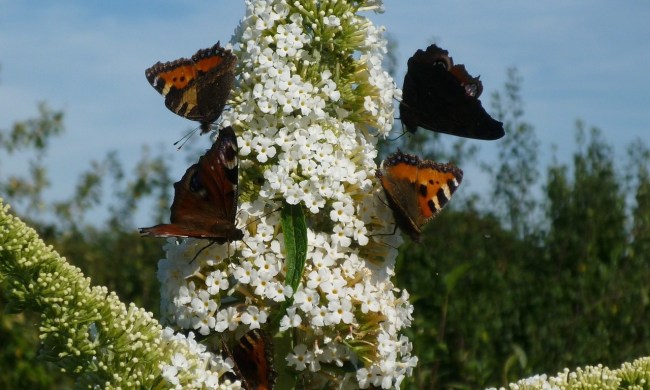The outdoors in winter can seem bleak and barren, but there are actually many plants that still thrive in the snow! In addition to early blooming flowers and winter vegetables, there are many types of evergreens. If planting different types of pine tree isn’t your idea of a good time, then consider planting some winterberry trees instead. This lovely tree is great for most types of gardens and can provide color and interest to your winter garden. Want to get started growing your own winterberry tree? Here’s everything you need to know in order to successfully care for your winterberry.
What are winterberries?

A winterberry tree is a small tree or shrub in the holly family. Ilex verticillata is the botanical name, but it’s typically easy to find under the common name winterberry. True to its name, this shrub produces red or orange berries in late fall and winter. Although it is a type of holly, it doesn’t have the glossy, spined leaves characteristic of English holly. Instead, it has long, oval leaves that are a lighter shade of green and don’t spines. These plants are also dioecious, meaning the male and female flowers appear on different plants. That means if you want to see berries, you’ll need at least two winterberry trees.
Winterberries are native to the eastern and northeastern U.S. as well as parts of Canada. They adapt well to cold winters and is an important winter food source for many types of wildlife. Birds eat the berries and deer will sometimes eat the leaves. Even rabbits will sometimes snack on the berries and leaves, making this a great plant for wildlife enthusiasts of all types. However, this plant is poisonous to people, as well as dogs and cats.
Planting winterberry trees

Winterberries are slow-growing trees, and they can grow up to 15 feet tall (and nearly as wide) under the right circumstances. However, most winterberry shrubs stay smaller than that, and there are dwarf varieties available. Choose a planting site with several feet of space in every direction so your winterberry won’t be crowded. You can grow winterberries in containers, although you may need to transplant them into your garden eventually.
Winterberry shrubs are not terribly picky about soil and will grow in average or regular soil. However, they do best in soil that’s moderately wet and slightly acidic. Avoid soil that drains quickly, as well as denser, clay-heavy soils, as these can drain too slowly and compact the roots. Adding compost to the soil can help improve the drainage of clay soils, while peat moss or perlite can help if the soil drains too quickly.
Winterberry trees are adaptable and can grow in most lighting conditions. Full to partial sun is ideal, but winterberries can tolerate light shade as well. Avoid planting your winterberry tree in full or deep shade. While the plant can survive for some time in full shade, it won’t produce nearly as many flowers or berries.
Winterberry care

Winterberry shrubs are not drought tolerant, and they need regular watering. Roughly an inch of water each week is ideal, especially during the first few months after they’ve been planted. Avoid watering your winterberry after a rainstorm, as they can still develop root rot or fungal infections if overwatered. Your winterberry may need more frequent watering during summer, droughts, or if it is in full sun. However, it will need slightly less water during winter.
As slow-growing plants, winterberry shrubs don’t need regular fertilizing. If your soil is naturally poor or you begin to notice signs of a deficiency, such as stunted growth, misshapen leaves, or leaves dropping out of season, then your winterberry may appreciate the boost that comes from fertilizer or compost. A balanced fertilizer suited for plants that prefer acidic soil is perfect for your winterberry, but they will do just fine with compost as well.
Winterberry shrubs are typically unbothered by insects, but many birds and mammals use them as a food source. Birds, deer, rabbits, voles, and squirrels all eat parts of this shrub on occasion, although birds are the most common visitors. While these can impact the appearance of your plant, they rarely cause significant damage.
Pruning your winterberry

Winterberry trees are easy to prune and typically only need light pruning. In fact, a heavy pruning session can result in a skipped or reduced flowering season (which also means fewer berries), so it’s best to keep your pruning to a light trim. Focus on removing damaged or diseased branches, then trim any remaining branches that are longer than they should be. Pruning helps control the size and shape of the plant while encouraging it to put out new stems and branches. As for timing, winterberries should be pruned in early spring, right before the plant begins producing new growth.
Winterberry trees are a delightful native plant that can liven up a winter garden or landscape. Whether you want to grow them to encourage birds to visit your yard or simply because you enjoy the color of the berries, these shrubs are lovely to have around. They’re also quite easy to grow, as long as you have plenty of water to share with them.




